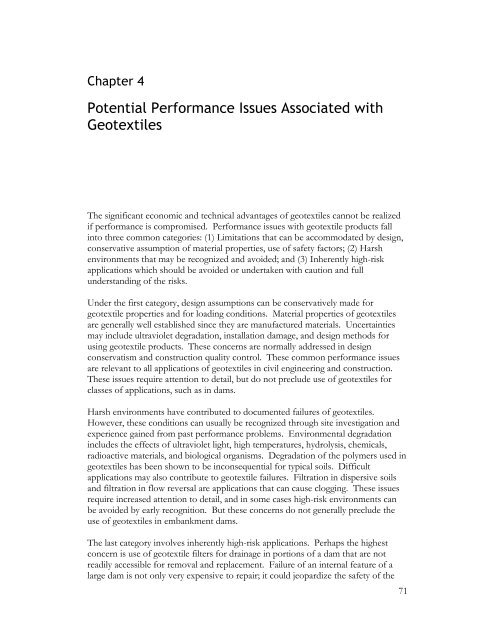Geotextiles in Embankment Dams - Association of State Dam Safety ...
Geotextiles in Embankment Dams - Association of State Dam Safety ...
Geotextiles in Embankment Dams - Association of State Dam Safety ...
You also want an ePaper? Increase the reach of your titles
YUMPU automatically turns print PDFs into web optimized ePapers that Google loves.
Chapter 4Potential Performance Issues Associated with<strong>Geotextiles</strong>The significant economic and technical advantages <strong>of</strong> geotextiles cannot be realizedif performance is compromised. Performance issues with geotextile products fall<strong>in</strong>to three common categories: (1) Limitations that can be accommodated by design,conservative assumption <strong>of</strong> material properties, use <strong>of</strong> safety factors; (2) Harshenvironments that may be recognized and avoided; and (3) Inherently high-riskapplications which should be avoided or undertaken with caution and fullunderstand<strong>in</strong>g <strong>of</strong> the risks.Under the first category, design assumptions can be conservatively made forgeotextile properties and for load<strong>in</strong>g conditions. Material properties <strong>of</strong> geotextilesare generally well established s<strong>in</strong>ce they are manufactured materials. Uncerta<strong>in</strong>tiesmay <strong>in</strong>clude ultraviolet degradation, <strong>in</strong>stallation damage, and design methods forus<strong>in</strong>g geotextile products. These concerns are normally addressed <strong>in</strong> designconservatism and construction quality control. These common performance issuesare relevant to all applications <strong>of</strong> geotextiles <strong>in</strong> civil eng<strong>in</strong>eer<strong>in</strong>g and construction.These issues require attention to detail, but do not preclude use <strong>of</strong> geotextiles forclasses <strong>of</strong> applications, such as <strong>in</strong> dams.Harsh environments have contributed to documented failures <strong>of</strong> geotextiles.However, these conditions can usually be recognized through site <strong>in</strong>vestigation andexperience ga<strong>in</strong>ed from past performance problems. Environmental degradation<strong>in</strong>cludes the effects <strong>of</strong> ultraviolet light, high temperatures, hydrolysis, chemicals,radioactive materials, and biological organisms. Degradation <strong>of</strong> the polymers used <strong>in</strong>geotextiles has been shown to be <strong>in</strong>consequential for typical soils. Difficultapplications may also contribute to geotextile failures. Filtration <strong>in</strong> dispersive soilsand filtration <strong>in</strong> flow reversal are applications that can cause clogg<strong>in</strong>g. These issuesrequire <strong>in</strong>creased attention to detail, and <strong>in</strong> some cases high-risk environments canbe avoided by early recognition. But these concerns do not generally preclude theuse <strong>of</strong> geotextiles <strong>in</strong> embankment dams.The last category <strong>in</strong>volves <strong>in</strong>herently high-risk applications. Perhaps the highestconcern is use <strong>of</strong> geotextile filters for dra<strong>in</strong>age <strong>in</strong> portions <strong>of</strong> a dam that are notreadily accessible for removal and replacement. Failure <strong>of</strong> an <strong>in</strong>ternal feature <strong>of</strong> alarge dam is not only very expensive to repair; it could jeopardize the safety <strong>of</strong> the71
















